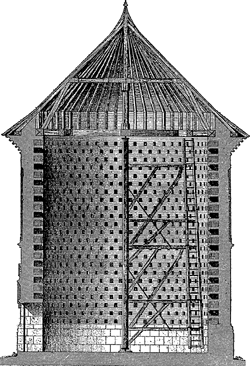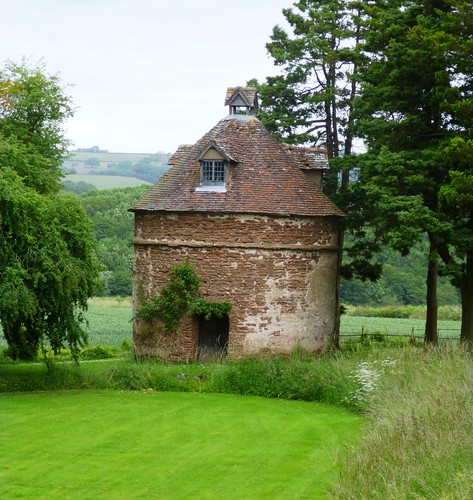PAGE 1 to 5:
These ideas aim to help us all creating an immersive world. These are no rules. Each bulletpoint should be considered critically depending on the context. (i.e. If you're build is in Dorne, extensive gardens or veggie patches are nonsense). Use these with common sense and in stark moderation.
Check this homepage for inspiriation and to learn exactly how structures were supported and mechanisms worked:
http://www.castlesandmanorhouses.com/life.htm
Small Villages and Hamlets:
- Stalls, troughs, paddocks for livestock
- barns
- sheds (tools, dry elevated storage for food, etc.), chicken or rabbit coops
- chopped wood blocks (wood piles) below roof overhangs + chopping block with the axe nearby
- fruit trees, bushes, "wild vegetation" (not big & organized orchards), but several small ones around /near the village.
- Vegetable Patches, Gardens, Small stone walls or hedges or fences to mark property
- Compost heaps
- A laundry place outside the buildings (water barrel if no stream is nearby, and a simple cloth line)
- Depending on the profession: Beehives, Barrels of ale, Sand on the ground as flour, etc.
- Cesspit, Gongfarmers
- Carpenter + woodsaw
- Logging camp + sawpit
- Mill (water, wind, tide, animal, manual)
Fields:
- Haystacks
- Yoke, Till, Carts
- Wheelbarrows
Castles:
- Lord's Hall
- Bower (the Lady's private drawing room)
- Wardrobe (dressing room, storage for valuables)
- Bath Room (attached to wardrobe)
- Knitting Room
- Feast Hall
- Minstrel's Gallery
- Throne Room (later addition to castles)
- Privies, Chamberpots, Garderobes (the latrine type) [Sorry for the german wiki here but the english one is devoid of relevant info and pics.], Dansker
- Brattices, Machicolation, Arrowslits, Murderholes
- Laundry Room
- Meat Storage (salted, dried, smoked, cold) , vegetable vellar, whine cellar
- Cells, Dungeons, Torture rooms, shackles.
- Stocks, pillory, gallows, chopping block, Cages.
- Kitchen
- Buttery (storage for ale/beverage)
- Bottlery (storage for wine/expensive provisions)
- Pantry (storage for perishable foods - no ice for 'refridgeration')
- Sept
- Oratory (private chapel)
- Dresser
- Stables
- Granary
- Kennels
- Cistern, well, artesian well
- Training Yard, Arrow range, Jousting lanes, Dummies for all of those.
- Armory, Guardposts, Head of the Guard chamber, Barracks.
- Dungeon
- Maester's Chamber, Rookery, Herbgarden, [Glas gardens], medical supplies, leeching room.
- Bathhouse
- Gatehouse
- Bailey
Mods please feel free to just edit more stuff in or regroup my ramblings. Builders feel free to post more ideas, please refrain from discussion and keep this informative.
There is good evidence to suggest that castle barracks didn't exist in the 16th century and before. While Romans had temporary barracks for military campaigns, castles didn't have large standing armies where they would need to house military men for long periods of time. Knights and peasant infantry would have their own homes, while professional soldiers would sleep in the guard towers near their posts or with the other servants in the great hall after the evening meal was served and the trestle tables were removed.
http://www.answers.com/topic/barracks-2
http://www.castlewales.com/life.html
http://en.wikipedia.org/wiki/Barracks
http://answers.yahoo.com/question/index?qid=20101219090134AARvAA0
http://www.ancientfortresses.org/medieval-great-hall.htm
In general, these sites have tons of interesting information about medieval castles and medieval life:
http://www.ancientfortresses.org/rooms-in-a-medieval-castle.htm
http://www.castlesandmanorhouses.com/architecture.htm
http://www.medieval-life-and-times.info/medieval-castles/index.htm
http://www.ancientfortresses.org/
http://www.castlewales.com/life.html
Along this topic, I know I might be a broken record, but I have more info for us to consider on glassmakers:
glass production was not reserved just for ports, beaches and other sandy places, Forest glass is late medieval, and the workshops were commonly located within forests, near riverbeds where the sand would be sourced from.
http://en.wikipedia.org/wiki/Forest_glass
These forest glass houses most commonly used beech wood, and were usually located in forests belonging to the Church. The glasshouses needed to be located in forests to source the huge amount of wood needed . The woodlands were managed - but sometimes the glass houses needed to move.
some images:
http://glassian.org/Making/Diderot/crown_glasshouse.html
http://www.medievalists.net/wp-content/uploads/2011/03/Unknown9.jpeg
http://www.uh.edu/engines/glass.jpg
and a couple really nice pdfs:
http://www.english-heritage.org.uk/publications/iha-glassworks/M_and_EPM_Glassworks_IHA_final.pdf
http://www.english-heritage.org.uk/publications/glassworkingguidelines/glassworking-guidelines.pdf
hought I'd post these:
http://www.britainexpress.com/History/Feudalism_and_Medieval_life.htm#Manors
http://www.britainexpress.com/History/Townlife.htm
Here's a huge repository of information:
http://the-orb.net/encyclop/culture/towns/towns.html
Though unfortunately many of the links are broken. A bunch still work though.
http://www2.uncp.edu/home/canada/work/markport/lit/introlit/ms.htm
Simple, well explained guide concerning medieval manuscript making. I based my Street of Gold house off of this in LP, but I suppose it will be useful for Oldtown, when we cross that road.
Hi, recently I've been addicted to building inns and manors on the server. And after a few (and doing research on how they looked) I would like to share these two links that I love to use for ideas. (sorry for not putting them up earlier). The first link is a pdf that solely focuses on medieval Inns, tavern, or alehouses (which ever one you prefer). The second link brings you to the inn/tavern/alehouse page, however to the left its chock full of more useful links, to other things you might find in a caste, town, or a certain building. Also before I stop rambling here, some also have some "schematics" (however you'd depict a schematic to look like) Hope these two links are useful as they were to me!
PDF: http://cwoodlibrary.weebly.com/uploads/5/2/8/9/5289432/inns_and_taverns_in_the_middle_ages.pdf
Chock full of Stuff: http://www.buildinghistory.org/buildings/churchhouses.shtml
About castle life: http://www.castlesandmanorhouses.com/life.htm
So here's 3 nice videos to educate yourselves some more on castle building. They give you great knowledge on how fortified walls were in the medieval times, and what materials were used where. Also in the second video the narrator kinda talks about how much each person would get paid. Something to help show how poor people were actually back then. (think it'll help with making houses more realistic to the jobs they are assigned to) Its also filled with chock full of other fun educating facts about castles (how expensive they cost, defenses, and more that I'm not gonna say cause you'll have to watch ;-) )
Video #1:
Video #2:
Video #3:
Enjoy the videos! (would really like it if you put it in the Inspirational Guide thread)
Here's two links for sites with great examples of English and French castles. Both show the castles as they would have looked in their prime, an invaluable perspective as most intact castles today are either 19th century reconstructions or ruined hulks. Hopefully these will inspire some ultra-realistic castles on the server.
http://www.heritage-explorer.co.uk/web/he/search.aspx?crit=reconstruction castle&rt=0
* this one I have just searched for reconstruction images of castles, there are loads of other images throughout the site.
http://www.lostincastles.com/
*Really in-depth 3d models
TIL: Many older farm houses had the residency directly attached to the animal barn, because the heat given off by the animals would help heat the house a little bit.
http://themiddleagesjpf.weebly.com/uploads/1/9/5/6/19564697/8001565.jpg[/quote]
Here's a site with an artist's drawings of castle reconstructions throughout Germany. Its all in German, but its easy enough to figure out.
http://burgrekonstruktion.de/main.php
Just pick a region and there's a whole bunch of drawings. I think maybe around 200.
I see some of these as ideal for the Stormlands. Too bad the Vale is relatively complete.












